Your triceps make up nearly 70% of your upper arm mass. Yet, most people spend 80% of their arm day doing bicep curls.
Big mistake.
I learned this the hard way. For years, I hammered my biceps with set after set of curls, wondering why my arms weren’t growing. Then I discovered the power of strategic triceps training.
That I will share with YOU.
This includes 21 best triceps exercises targeting all three heads of the triceps. These aren’t just my opinions—they’re backed by EMG studies showing maximum triceps activation.
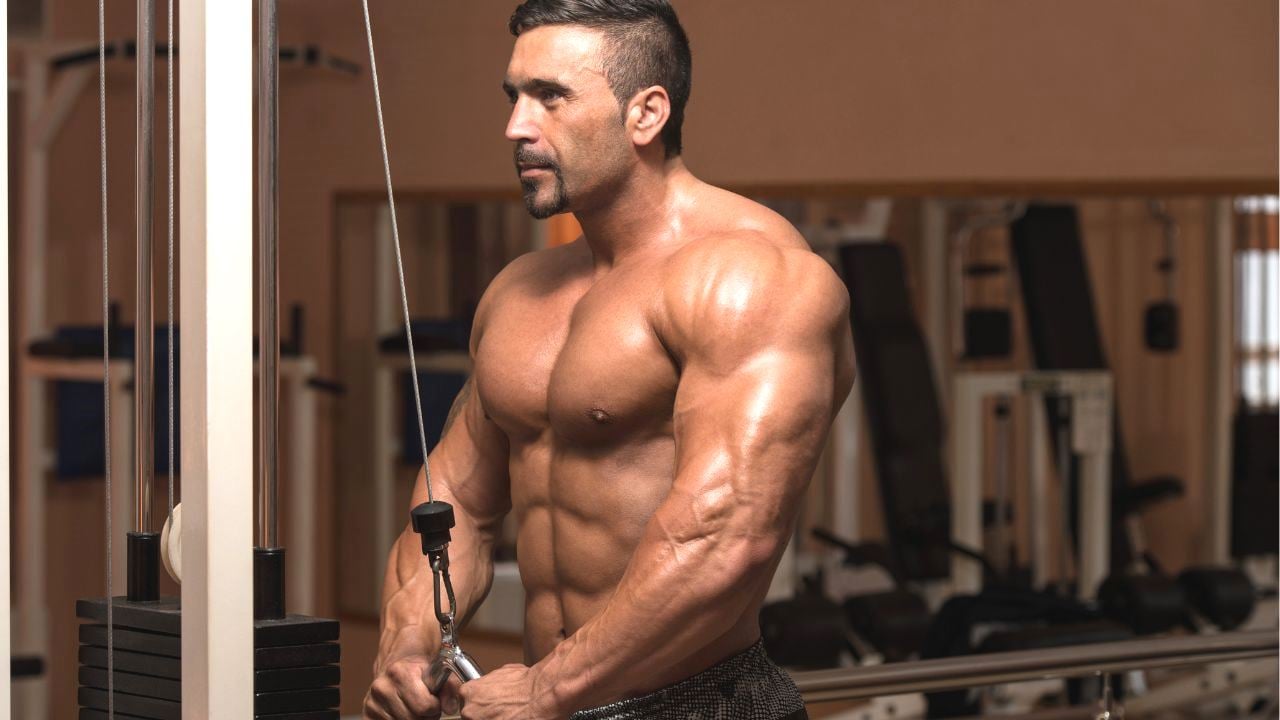
- 21 Best Tricep Exercises To Build Mass and Strength
- 1. Diamond Push Up
- 2. Kneeling Bodyweight Triceps Extension
- 3. Bench Dip
- 4. Parallel Bar Triceps Dip
- 5. Stability Ball Push Up
- 6. Overhead Dumbbell Triceps Extension
- 7. One-Arm Overhead Dumbbell Tricep Extension
- 8. Dumbbell Kickback
- 9. Dumbbell Lying Triceps Extension
- 10. Close-Grip Dumbbell Press
- 11. Tricep Pushdown
- 12. Reverse-Grip Tricep Pushdown
- 13. Cable Tricep Kickback
- 14. Overhead Cable Tricep Extension
- 15. One Arm Reverse Grip Tricep Pushdown
- 16. Lying Barbell Triceps Extension
- 17. Overhead Barbell Tricep Extension
- 18. Close-Grip Bench Press
- 19. Resistance Band Tricep Extension
- 20. Resistance Band Tricep Pushdown
- 21. Resistance Band Kickback
- Triceps Training Blueprint: Volume, Reps & Plans
- The Perfect Weekly Volume
- Rep Ranges That Trigger Maximum Growth
- Training Plan As Per Your Goal
- Beginner Tricep Workout Routine
- For Intermediate
- FAQs
- The best triceps exercises for hitting all heads.
- How often should I train my triceps for maximum mass?
- Are dips effective for building triceps mass?
- Should I do isolation exercises or compound exercises for triceps mass?
- Takeaways
21 Best Tricep Exercises To Build Mass and Strength
These best tricep exercises for mass and strength are divided into:
- Bodyweight Tricep exercises
- Dumbbell tricep exercises,
- Best Cable Tricep Exercises
- Barbell Tricep Workout
1. Diamond Push Up
Many people see the standard push-up as a chest exercise, and while it works the chest, varying your hand position(placing close) can dramatically shift the emphasis on the triceps.
The Diamond Push-Up is the best push-up variation for directly targeting your triceps. It is my favourite tricep workout.
Simply put, it’s a push-up performed with your hands placed close together directly under your chest, typically with your index fingers and thumbs touching to form a “diamond” or triangle shape.
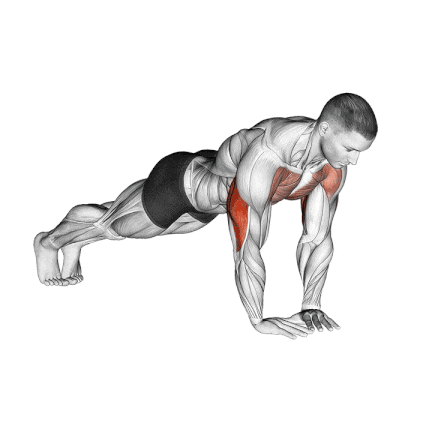
How To Do It
- Get into a standard push-up position on the floor, but place your hands close together directly under the center of your chest.
- Position your hands so your index fingers and thumbs touch, forming a “diamond” or triangle shape.
- Now, extend your arms to elevate your body and form a straight line from your head to your feet.
- Lower your chest towards your hands, ensuring your elbows don’t flare to the sides, and keep your back flat.
- Stop just before your chest touches the floor, then push back up to the starting position.
Tips
- Your body should form a straight line from your head to your heels. Engage your core and glutes – imagine balancing a glass of water on your back.
- To make the diamond push-up easier, do it on your knees.
- Go through the full range of motion. Lower your chest as close to your hands as possible without pain or losing form.
2. Kneeling Bodyweight Triceps Extension
In contrast to push-ups, which involve substantial shoulder movement (flexion/adduction), the bodyweight triceps extension restricts movement to the elbow joint.
It is one of the best exercises for isolating your triceps brachii without dumbbells, barbells, or weight machines.
It is highly effective in replicating the movement pattern of popular weighted exercises, such as the overhead dumbbell or cable tricep extension, while utilising only your bodyweight.
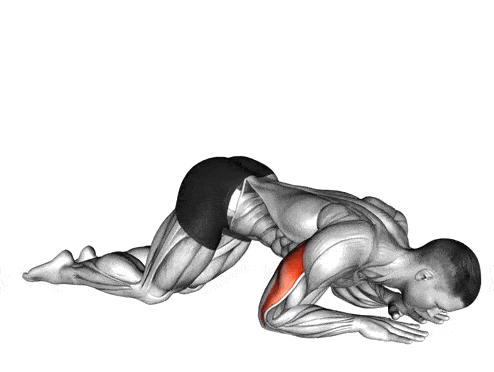
How To Do It
- Kneel on the floor, ideally with a mat for comfort.
- Your knees should be directly under your hips, or slightly further back if needed for balance.
- Lean your torso forward from the knees, keeping a straight line from your head through your hips to your knees.
- Extend your arms overhead and place your palms flat on the floor, hands roughly shoulder-width apart.
- Inhale as you slowly lower your chest towards the floor by bending only at the elbows. Avoid letting elbow flare out wide to the sides.
- Exhale powerfully as you extend your elbows and press your body back up to the starting position.
Tips
- Keep your elbows tucked into your body. Do not flare them out.
- Keep your torso rigid and maintain that straight line from head to knees. Do not let your hips sag or pike up.
- The further your hands are from your knees, the harder the exercise will be (more body weight leverage). Find a distance where you can maintain perfect form for your target rep range.
3. Bench Dip
The bench dip is a classic bodyweight exercise I frequently recommend to clients who want to build triceps strength, muscle definition, and push endurance without needing a full gym setup.
It is a simple yet effective tricep exercise that can be performed anywhere with a stable bench, chair, or step.
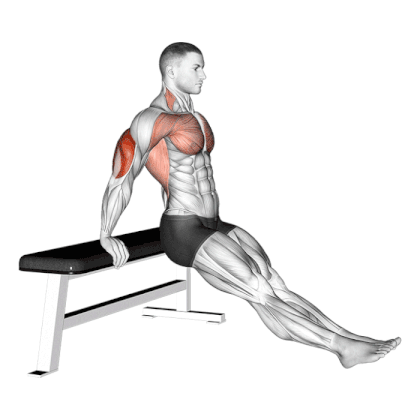
How To Do It
- Sit on a sturdy bench or box, hands gripping the edge just beside your hips, fingers pointing forward.
- Slide your hips off the edge and walk your feet forward, knees bent at 90° or extended straight (more advanced).
- Keep your chest lifted, shoulders pulled back, and elbows close to your body.
- Lower your body by bending your elbows, keeping them pointed straight back, not flaring out.
- Descend until your upper arms are roughly parallel to the floor (90° elbow bend).
- Press yourself back up by fully extending the elbows, engaging the triceps without locking out aggressively.
Tips
- You should only lower until your elbows are at a 90-degree angle (upper arms parallel to the floor), unless you have good shoulder mobility and stability and have tested a deeper range safely with lighter loads.
- Like push-ups, keep your elbows tucked in and tracking straight back, not flaring wide. This keeps the tension on the triceps.
- Keep your back close to the bench as you lower. When a person skates too far out, their movement becomes more horizontal and can cause awkward shoulder strain.
Want to take your gains to the next level? Discover your daily calorie needs with our free TDEE calculator
4. Parallel Bar Triceps Dip
Dips are a benchmark for upper body strength and the most effective compound movements for the upper body pushing muscles – the chest and triceps.
Compared to bench dips, this variation involves lifting your entire bodyweight vertically, adding a layer of intensity and full-body engagement.
Keep your torso more upright to emphasise the triceps. Leaning too far forward turns this into a chest dip—still great, but not the goal.
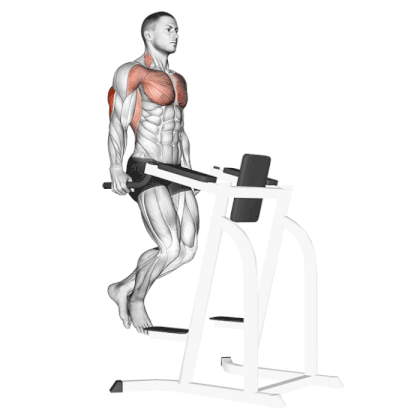
How To Do It
- Approach the parallel bars. Grip the bars with a neutral grip (palms facing each other). Hands slightly wider than shoulder width are generally comfortable for triceps-focused dips, but find what works for your body.
- Push off the floor (or step off the assist machine) to suspend yourself with arms fully extended.
- Cross your ankles behind you to help keep your body stable. Pull your shoulders down and back.
- Slowly lower your body until your upper arms are roughly parallel to the floor, or slightly below (elbows at about 90 degrees or a little more).
- Pause briefly in the bottom position, feeling the stretch in your triceps. Ensure your shoulders are still pulled down and back.
- Exhale powerfully as you press yourself back up to the starting position by extending your elbows. Return to full elbow extension. Squeeze your triceps hard at the top.
Tips
- Maintain the upright torso position (don’t lean excessively forward if you’re targeting triceps).
- Focus on keeping elbows tucked. This might mean adjusting your grip width slightly on the bars. It keeps tension on the triceps and is better for the shoulders.
5. Stability Ball Push Up
If you’re looking for a way to get more creative with your tricep workout, why not try a Stability Ball Push?
I see the stability ball as more than just a piece of equipment; it’s a challenge. It forces your body to work in ways that stable surfaces don’t, demanding more from your smaller stabilising muscles and core.
Some researchers have discovered that when you do unstable push-ups, your triceps, core stabilisers, prime movers, and lower body stabilisers become more active.
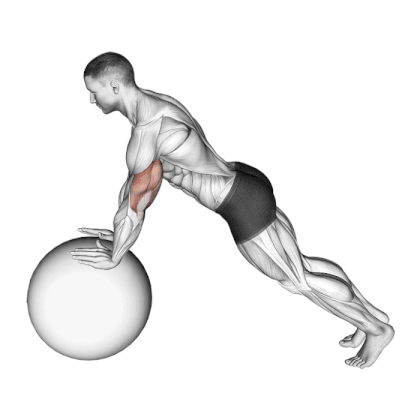
How To Do It
- Place your hands on the stability ball, slightly wider than shoulder-width apart. Secure the ball by wrapping your fingers somewhat down the sides to enhance your control.
- Walk your hands forward on the ball, or walk your knees backward, until you are in a push-up position with your hands on the ball and your body in a straight line from head to heels (or head to knees for a regression).
- Tighten your core, glutes, and quads to create a solid plank. Your body should be rigid, and your eyes should look slightly forward.
- Bend your elbows and gradually lower them as comfortably as possible without losing form or control of the ball.
- Exhale forcefully as you extend your elbows to push back up to the starting position.
- Repeat 8–12 repetitions.
Tips
- Don’t just rest your palms. Actively grip the sides of the ball with your fingers. This gives you more control.
- Keep your body in a straight line – do not let your hips sag or pike up.
- Your neck should be aligned with your body, not tilted up, which could strain the neck.
6. Overhead Dumbbell Triceps Extension
The dumbbell overhead tricep extension is a fantastic exercise that builds optimal muscle and strength in all three heads of the tricep muscle.
It’s highly effective, relatively simple to learn, and requires minimal equipment – just a dumbbell and maybe a bench.
However, the long head originates on the scapula (shoulder blade) and crosses the shoulder joint. When your arm is raised overhead, the long head is stretched and contracts forcefully during the extension.
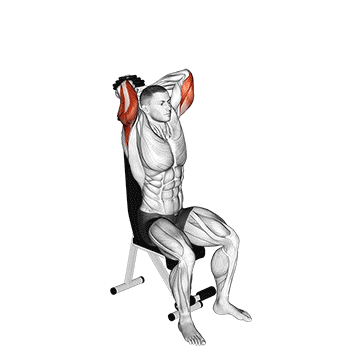
How To Do It
- Sit upright on a bench (with or without back support – back support can help maintain core stability).
- Grasp the dumbbell with both hands, cupping the weight head with your palms and thumbs around the handle (or hands flat against the underside of the top weight plate).
- Slowly lower the dumbbell behind your head, bending only at the elbows. Lower as far as you can comfortably without losing form.
- Keep your elbows tucked in close to your head or ears throughout the movement. They should point mostly forward or slightly outward, not flare out wide to the sides.
- Extend your arms back up while squeezing your triceps hard to get back to the starting position.
Tips
- Keep the head fairly neutral; don’t let the neck jut forward.
- The only joint that should be significantly moving is your elbow. Minimise swinging or movement at the shoulder.
- The chin should remain parallel to the floor, and the core should be braced.
7. One-Arm Overhead Dumbbell Tricep Extension
This exercise is excellent for building symmetry, control, and detail, especially when clients complain about one triceps lagging behind or feeling “less activated” in compound presses.
Training one side at a time can better engage the mind-muscle connection and fix any strength or size discrepancies.
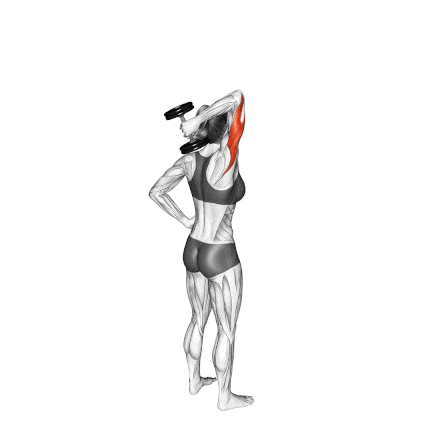
How To Do It
- Sit on a bench with a backrest. For stability, your feet should be flat on the floor, shoulder-width apart.
- Hold the dumbbell in one hand. Place your other hand on your hip or side for balance, or use it to gently support the elbow of your working arm if needed.
- Press the dumbbell overhead until your arm is straight. Rotate your wrist so your palm is facing inwards (neutral grip). Your upper arm should be close to your head, pointing straight up or slightly angled back.
- Keep your arm next to your head and lower the weight behind your head toward your left shoulder until your elbow is at a 90-degree angle.
- Push the dumbbell back up to the starting position overhead.
Tips
- Actively think about squeezing your triceps. Don’t just move the weight; contract the muscle.
- The chin should remain parallel to the floor, and the core should be braced throughout the duration of the exercise.
8. Dumbbell Kickback
Kickback engages all three; the specific position (bent-over, arm held back) emphasises the lateral and medial heads more, especially at the movement’s top. The long head is still working.
It is an isolation exercise, which means that, unlike other exercises such as the push-up or bench press, the tricep kickback targets explicitly the triceps muscle.
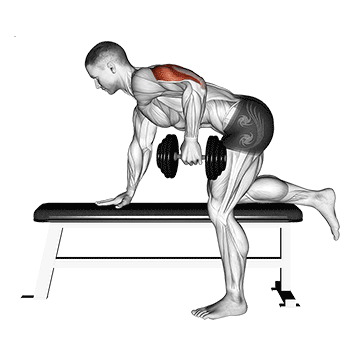
How To Do It
- Place your right knee and palm on a flat bench so that your torso is parallel to the floor.
- Hold a dumbbell in your left hand. Put your left foot flat on the floor and press your left arm tight against your side. Your upper arms should be straight out from your body.
- Bring the dumbbell up until your upper arm is parallel to the floor. Your upper arm should be relatively fixed here, only the lower arm move.
- Flex the triceps hard for a second, then return to the starting position.
- Complete all reps on the left arm and then repeat on the right arm.
Tips
- Use a weight that allows you to fully straighten your arm and hold a squeeze for a second. Don’t just go through the motion; focus on the muscle contraction at the top.
- Keep your body as still as possible; move only your forearms.
9. Dumbbell Lying Triceps Extension
The dumbbell lying tricep extension is an excellent tricep workout to begin your triceps routine.
It is an isolation exercise, which means it uses just one joint. This can be beneficial for correcting imbalances in the triceps.
It puts no pressure on the wrists, so they are an alternative for people with wrist strain or injury.
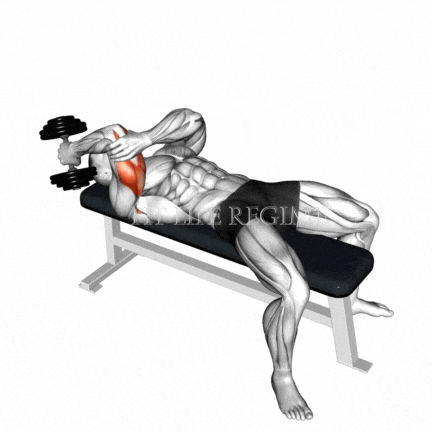
How To Do It
- Lie on a flat bench with your feet flat on the floor.
- Grasp a dumbbell in each hand and hold it directly above you with your palms facing inward (neutral grip).
- Ensure that your upper arms and elbows are still, lower the dumbbell behind your head, and feel a stretch in your tricep muscles.
- Pause and squeeze the triceps, and then raise the dumbbells back to the starting position.
Tips
- Concentrate on keeping your elbows stable.
- Do not allow your elbows to flare out to the sides.
- Slowly lower the weights, and do not use momentum.
10. Close-Grip Dumbbell Press
The barbell bench press is one of the most popular chest-building exercises, but many lifters suffer from shoulder pain when using the traditional barbell bench.
The neutral-grip dumbbell press is a great bench press alternative because it emphasizes chest and triceps without causing shoulder pain. Because your palms are facing each other, it reduces the strain on your shoulders.

How To Do It
- Sit down on the bench with a dumbbell in each hand. Use a weight that’s challenging but allows you to maintain good form.
- Lie back on the bench. Use your knees to help kick the weights up, one at a time, so you can hold them at chest level with your arms bent.
- The palms of your hands should be facing each other in a neutral grip.
- Position the dumbbells directly above your chest with your arms fully extended. This is your starting position.
- Inhale and slowly lower the dumbbells towards the sides of your chest.
- Keep your elbows at about a 45-degree angle to your body.
- Once the dumbbells are about even with your chest or slightly below (ensure your shoulders feel comfortable), pause briefly.
- Exhale and push the dumbbells back up to the starting position, contracting your chest muscles as you do so.
11. Tricep Pushdown
You’ve probably seen and even done the tricep pushdown more times than any other triceps exercise. It’s popular because it’s accessible, relatively easy to learn the basic movement pattern, and incredibly effective.
It is fantastic move for isolating the triceps and getting a serious pump. It allows for consistent tension throughout the range of motion.
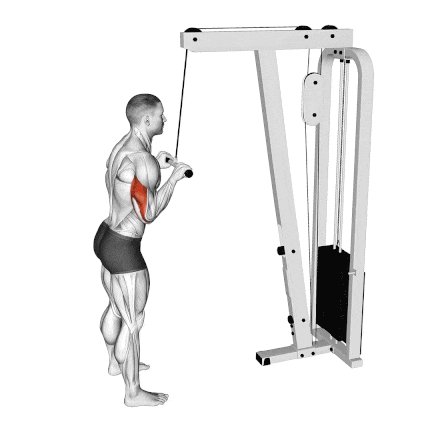
How To Do It
- Stand facing a cable machine with the pulley set at chest height or slightly higher. Choose your preferred attachment (straight bar, V-bar, or rope).
- Grab the attachment with an overhand grip (palms facing down) if using a bar, or a neutral grip (palms facing each other) if using a rope. Your hands should be about shoulder-width apart (or slightly narrower for bars), or holding the ends of the rope.
- Take a small step or two back from the machine to create tension on the cable.
- Stand with your feet shoulder-width apart, maybe one foot slightly forward for balance. Lean forward slightly from your hips.
- Keep your elbows glued to your sides. Push the bar/rope until your arms are fully extended, but avoid hyperextending your elbows.
- Slowly and under control, inhale and allow your elbows to bend, returning the bar/rope to the starting position.
- Go smoothly into the next repetition.
Tips
- A slight lean forward (5-15 degrees) from the hips is fine and often helps keep elbows tucked, but don’t turn it into a lat pulldown or lean back.
- Don’t let your hands or forearms come much higher than parallel to the floor at the top. Going higher often causes elbows to drift forward, releasing tension from the triceps.
12. Reverse-Grip Tricep Pushdown
The reverse grip (supinated) position places your elbows slightly more forward, which helps activate the long and medial head more effectively.
The reverse grip naturally allows for a slightly greater range of motion at the elbow joint. This extended range can lead to better muscle stretching and contraction.
This variation often requires more focus and control, as it’s less stable than the traditional grip.
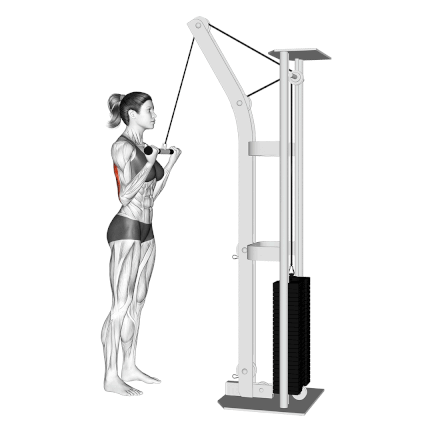
How To Do It
- Stand facing a high-pulley cable with a short straight bar attached to it.
- Slightly bend your knees, and your feet should be about shoulder-width apart.
- Grasp the short bar with a supinated grip (Palm up) and hold the bar at chest level with your elbows tight against your sides.
- Keeping your elbows stationary, straighten your arms until they are fully extended.
- Pause at full arm extension, flex your triceps, and slowly return the bar to the starting position.
Tips
- Don’t lock the elbows entirely if you want to keep more tension in the triceps.
- Prevent your elbows from flaring out to maintain proper form.
- Focus on keeping your back straight and your chest high.
To Stay Motivated: 150+ Gym Workout Motivational Quotes To Stay Fit
13. Cable Tricep Kickback
One good example of a single-arm tricep cable exercise is the cable tricep kickbacks. Most people perform this exercise just by using a cable.
It is a versatile and practical exercise that builds strength and muscle in all three heads of tricep muscle.
Using cables aims to maintain constant tension on target muscles, which is important for muscle hypertrophy.
This continuous resistance makes it a more beneficial method for muscle gain. Using cables can be both practical and easier for beginners.
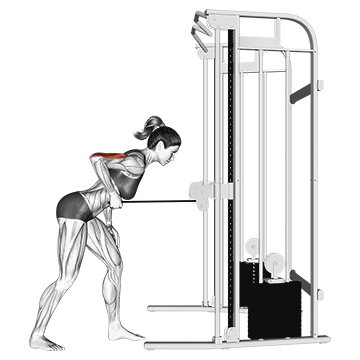
How To Do It
- Attach a single grip rope handle to the lowest notch on the cable pulley system.
- Then, bend your knees, keep your back straight, and grab the rope with your left hand.
- With your upper arms parallel to the floor, extend at the elbow until your arm is straight back and fully extended.
- Flex the triceps hard for a second, then return to the starting position.
- Complete all reps on the left arm and then repeat on the right arm.
14. Overhead Cable Tricep Extension
The overhead rope tricep extension is one of the best isolation exercises to target the long head of the triceps.
I discovered how effective this exercise was in 2022 when preparing for a physique competition.
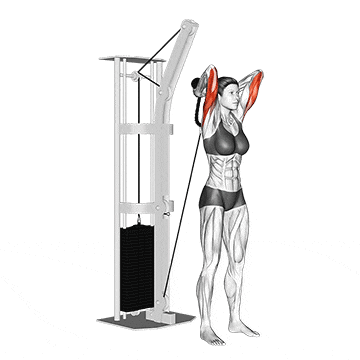
How To Do It
- Attach a rope to the bottom pulley of the cable machine and face away from the pulley.
- Hold the rope with both hands, palms facing each other (neutral grip)
- Now, extend your arms until your hands are directly above your head.
- Your elbows should be close to your head, and your arms should be perpendicular to the floor.
- Slowly lower the rope behind your head as you hold the upper arms stationary. I
- Slowly return to the starting position and repeat the desired number of sets and reps.
Tips
- Never load up to where you cannot maintain a stable body position.
- Keep your arms close to your head for maximum triceps engagement.
- Perform the exercise using a slow and controlled movement from start to finish.
15. One Arm Reverse Grip Tricep Pushdown
The cable one-arm reverse-grip tricep push-down is an isolation exercise that builds muscle and strength in all three tricep heads.
Now, push-downs are excellent regardless of the variation, but the reverse grip may allow you to emphasize the outer tricep head more.
For building muscle, you should include these exercises in your triceps workout.
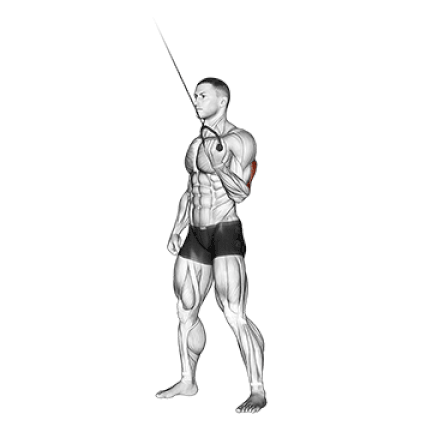
How To Do It
- Stand near the cable apparatus and grasp the single-grip attachment with an underhand grip.
- Keep your elbows at your body’s sides, and press the weight downward while exhaling throughout the movement.
- If desired, you may self-spot with your free hand.
- Slowly allow the weight to rise until your forearms are parallel to the ground, inhaling throughout the negative motion.
- Repeat steps 3-4 for as many sets as are desired.
Tips
- Keep your upper arm as still as possible, only allowing your forearm to move.
- Squeeze the tricep hard at the top of the exercise to get that extra pump!
16. Lying Barbell Triceps Extension
The lying barbell triceps extension (aka skull crushers) might be old school, but there’s a reason it’s stood the test of time. When done correctly, this exercise delivers insane triceps growth that few movements can match.
According to recent research, the overhead position significantly increases triceps brachii hypertrophy, particularly in the long head.
To be honest, I don’t do many skull crushers because they hurt my elbows.
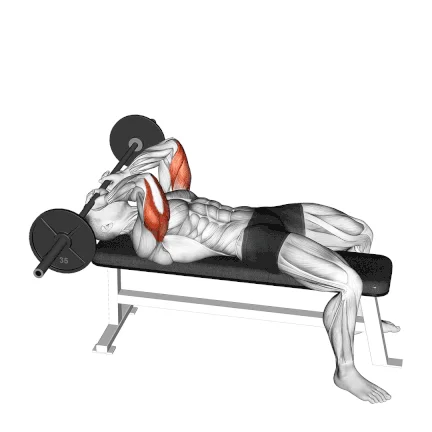
How To Do It
- Lie on a flat bench with your feet on the floor.
- Hold a barbell at full arm extension over your chest.
- Keeping your upper arms stationary, slowly lower your lower arms to bring the bar down to your forehead, then push it back up.
- Do not lock your elbows out, and repeat for desired reps.
Tips
- Switch to an EZ bar if you have wrist or elbow discomfort with a straight bar. The angled grips are often much more joint-friendly.
- Don’t go too wide. A grip slightly narrower than shoulder-width is usually optimal for targeting the triceps.
- This is an isolation exercise. Use a weight you can perform with perfect form for your target rep range. Heavy weight is good, but only if controlled.
17. Overhead Barbell Tricep Extension
I’ve been training clients for 10+ years, and I can confidently tell you this exercise transforms triceps development faster than almost anything else in your arsenal.
It works all three heads of the muscle, especially targeting the long head of the triceps.

How To Do It
- Stand with feet shoulder-width apart (or sit on a bench for back support).
- Hold a barbell (EZ bar or straight bar) with an overhand grip, hands slightly narrower than shoulder-width.
- Keep your upper arms right beside your head.
- Slowly lower the bar behind your head by bending your elbows until your elbows form 90-degree angles.
- Stop when your forearms are just past parallel to the floor (or when you feel a deep stretch in your triceps).
- Pause briefly, then extend your elbows to lift the bar back up to the starting position.
Tips
- Using the EZ bar instead of a standard barbell can be easier on your wrists.
- use 21s technique: 7 partial reps from the top position, 7 partial reps from the bottom position, then 7 full-range reps.
Know More Body Fat %: Use Our Free Body Fat Calculator
18. Close-Grip Bench Press
The close grip bench press is a variation of the bench press and an exercise used to build muscle and strength in the triceps.
It is a compound exercise that simultaneously works for multiple muscle groups. In addition to the triceps, it also works the chest, anterior deltoids, and serratus anterior.
A study has also shown that compared to the traditional bench press, this narrower grip shifts the emphasis more towards the triceps brachii and less on the pectoralis major and shoulder.

How To Do It
- Lie flat on your back on the bench. Plant your feet firmly on the floor.
- Reach up and grasp the barbell with a pronated (overhand) grip. Your hands should be closer together than your standard bench press grip.
- Grip the bar width that is approximately shoulder-width apart, or slightly narrower – no more than one hand width inside shoulder width on each side. Avoid gripping too narrowly, as this can place excessive stress on your wrists and elbows.
- Before unracking, retract your shoulder blades by squeezing them together and slightly depressing them (pulling them down towards your hips).
- Take a deep breath, brace your core, and unrack the bar from the supports with your elbows locked. Slowly move the bar forward so it is positioned directly over your chest.
- Lower the bar slowly and under control. Actively tuck your elbows towards your sides. They should track downwards at an angle of roughly 45 degrees relative to your torso.
- Exhale forcefully as you press the bar back up towards the starting position.
- Once you’ve completed your set, carefully return the bar to the rack.
Tips
- Keep your elbows at about a 45-degree angle relative to your torso. Avoid flaring the elbows out excessively or tucking them too close to your body.
- Do a full range of motion. Lower the barbell until it is close to your chest. Press it back up to full arm extension without locking out the elbows.
19. Resistance Band Tricep Extension
While weights and cables are gym staples, sometimes you need a portable workout solution, joint-friendly, and offers a unique type of challenge. The Resistance Band Triceps Extension is an absolute gem for this.
You can perform this tricep workout with a resistance band at home at the gym.
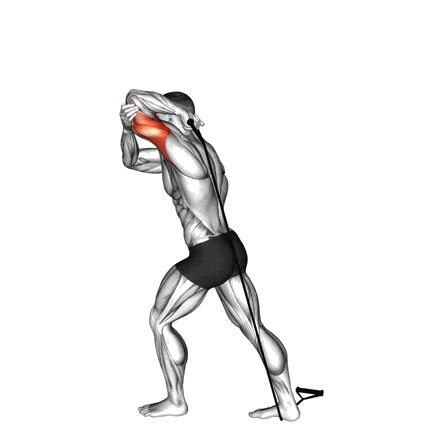
How To Do It
- Secure the band with an object, or place one foot in the middle of the band to secure it to the floor.
- Hold both handles and bring your hands behind your head.
- Your elbows should be pointing forward on either side of your head.
- Keep your elbows as close to your head as possible, and extend your arms to raise your hands.
- Shorten the length of the band between your foot and hand if there’s not enough resistance.
- Bring it back down and repeat.
Tips
- Keep your upper arms as still as possible.
- The chin should remain parallel to the floor and the core should brace during the exercise.
20. Resistance Band Tricep Pushdown
The bands are a great way to keep joints feeling healthy, as they are low impact on your elbows and shoulders.
Unlike dumbbells (which are hardest in the stretched position) or cables (which have relatively constant tension), resistance bands get harder the more they are stretched. This means the peak tension occurs at the top of the movement, when your arms are fully extended and your triceps are most contracted.
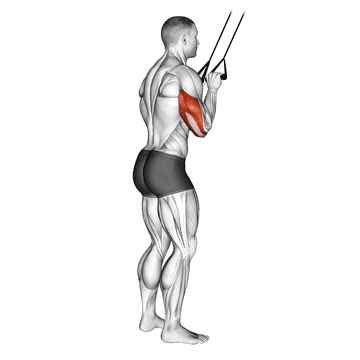
How To Do It
- Place a resistance band around a hook above your head.
- Grab the resistance band with both hands (palms facing in) just below chest height.
- Keep your elbows tight into your side and drive your hands down towards your waist.
- Lock your arms out and rotate your hands slightly outward as you do.
- Hold briefly, then bring your hands back up to just below chest height.
Tip
- Use only your forearms as you raise and lower the rope. The higher your hands start-up on the resistance band, the more resistance you will have and the harder the exercise will be.
- Control the band speed when your hands come back up.
21. Resistance Band Kickback
I discovered this exercise’s effectiveness during lockdowns when gym access was limited.
Using nothing but bands, I maintained more triceps definition than I expected. The secret? The constant tension and peak contraction that bands provide.
After I returned to the gym, I continued to include band kickbacks in my routine as the ideal way to finish a workout and achieve full triceps development.
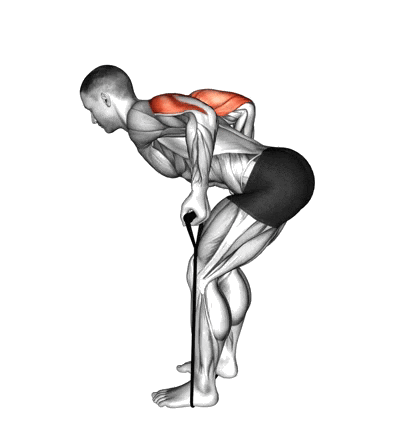
How To Do It
- Grab the handles with your palms facing towards you. Step on the resistance band with your feet.
- Keep your back straight, and hinge at the waist so that your back is nearly parallel to the ground.
- Contract your triceps to straighten your arms and press the handles backwards.
- Squeeze your triceps at the top of each rep and slowly return to the starting position. Repeat.
Tips
- Keep your elbows tucked in to practice proper form and maximize your gains.
Triceps Training Blueprint: Volume, Reps & Plans
I’ve tested dozens of training protocols over my 10+ years of coaching, and here’s the truth: your triceps growth is directly tied to training volume and intensity.
The Perfect Weekly Volume
Your ideal triceps volume depends entirely on your experience level:
- Beginners: 8-10 sets per week (split into 2 sessions)
- Intermediate: 12-15 sets per week (divided into 2-3 sessions)
- Advanced: 16-20 sets per week (split into 2-3 sessions)
When your progress stalls (and it will), adding just 2-3 sets per week can reignite your gains.
Rep Ranges That Trigger Maximum Growth
Contrary to popular belief, there’s not ONE perfect rep range. You need a strategic mix:
- Strength Focus: 6-8 reps with heavy weight (close to your 6-8RM)
- Hypertrophy (Muscle building): 8-12 reps with moderate weight
- Endurance: 15-20 reps with lighter weight
The key? Each set needs to bring you within 1-2 reps of technical failure. Anything less is just going through the motions.
Training Plan As Per Your Goal
- For muscle endurance: Aim for 3-4 sets of 12-15 reps, with moderate resistance. Rest 2-3 minutes between sets
- For muscle strength: Aim for 3-5 sets of 6-10 reps, with more resistance. Rest 60-90 seconds
- For muscle hypertrophy (increased muscle size): Aim for 3-4 sets of 8-12 reps, with a moderate to heavy amount of resistance. Rest 30-60 seconds
It is always best to start with fewer reps and sets and then gradually increase as your strength improves.
Beginner Tricep Workout Routine
Here is a beginner-friendly tricep workout routine to build mass.
| Exercise | Sets | Reps |
|---|---|---|
| Diamond Push-Ups | 3-4 | 8-10 |
| One-Arm Overhead Dumbbell Tricep Extension | 3-4 | 8 |
| Triceps Pushdown | 4 | 8-10 |
For Intermediate
Here is an intermediate tricep workout routine:
| Exercise | Sets | Reps |
|---|---|---|
| Bench Dip | 4 | 8-10 |
| Reverse-Grip Triceps Pushdown | 3-4 | 10-12 |
| Dumbbell Kickback | 4 | 10-12 |
| Overhead Barbell Triceps Extension | 3 | 8-10 |
FAQs
The best triceps exercises for hitting all heads.
Here are some of the best triceps exercises to hit all three heads of the muscle,
- Diamond Push Up
- Close-grip bench press
- Dips
- Kickback
- Skull crushers
- Pushdowns with various grip options.
By including a combination of these exercises in your workout routine, you can target all three heads of the triceps muscle for maximum strength and hypertrophy gains.
How often should I train my triceps for maximum mass?
To achieve maximum triceps mass, you should train your triceps at least twice a week, allowing for adequate rest and recovery between workouts.
Are dips effective for building triceps mass?
Yes, dips are an effective exercise for building triceps mass.
Dips target the triceps, chest, and shoulders and can be done with body weight or added weight.
When performed with proper form and progressive overload, dips can help increase triceps mass and strength.
Should I do isolation exercises or compound exercises for triceps mass?
It’s a good idea to include a combination of both isolation and compound exercises in your training program to build triceps mass.
- Compound exercises such as dips and close-grip bench presses target multiple muscle groups, including the triceps, chest, and shoulders, and can be great for overall upper body strength and mass.
- Isolation exercises such as triceps extensions and kickbacks specifically target the triceps, which can help to increase muscle activation and hypertrophy in that area.
Takeaways
Training the triceps is important for building tricep mass and improving upper body strength and performance.
Compounding exercises, such as dips and bench presses, can effectively target the triceps. However, isolation exercises, such as kickbacks and tricep extensions, can also be beneficial.
When doing these exercises, do them correctly and with good technique.
Also, gradually increase the weight and try different reps to keep the muscle working hard and getting bigger.
Thanks for reading; enjoy the workout!

Manish is a NASM-certified fitness and nutrition coach with over 10 years of experience in weight lifting and fat loss fitness coaching. He specializes in gym-based training and has a lot of knowledge about exercise, lifting technique, biomechanics, and more.
Through “Fit Life Regime,” he generously shares the insights he’s gained over a decade in the field. His goal is to equip others with the knowledge to start their own fitness journey.

Overall, I think he is correct or beast! I used alot of those exercises with great success without being on anything or supplements.
Thanks.
Stay Fit, Live A Happy and Healthy Life.